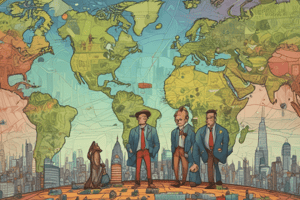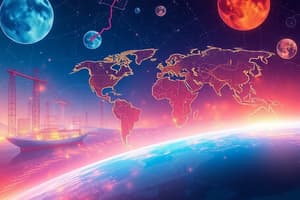Podcast
Questions and Answers
Which scenario best exemplifies a microeconomic decision?
Which scenario best exemplifies a microeconomic decision?
- An individual deciding whether to spend their bonus on a new appliance or invest it. (correct)
- A country negotiating a trade agreement with another nation.
- A central bank adjusting interest rates to control inflation.
- A government increasing income tax rates to fund public services.
Which of the following is a primary focus of macroeconomic study?
Which of the following is a primary focus of macroeconomic study?
- The impact of a new smartphone on consumer behavior.
- How a small business can maximize its profits.
- The effect of government policies on national unemployment rates. (correct)
- The pricing strategy of a local coffee shop.
What aspect of international economic relations does global economics primarily address?
What aspect of international economic relations does global economics primarily address?
- The labor practices within a specific industry in a developing country.
- The effects of exchange rates on international trade balances. (correct)
- The internal production costs of a multinational corporation.
- The fluctuations in supply and demand for a single commodity.
What was the primary purpose of the Silk Road?
What was the primary purpose of the Silk Road?
Which of the following best describes the economic impact of the Age of Discovery?
Which of the following best describes the economic impact of the Age of Discovery?
What technological development significantly propelled the First Wave of Globalization?
What technological development significantly propelled the First Wave of Globalization?
The establishment of which international organization is most closely associated with the Second Wave of Globalization?
The establishment of which international organization is most closely associated with the Second Wave of Globalization?
What technological advancement is most characteristic of the Third Wave of Globalization?
What technological advancement is most characteristic of the Third Wave of Globalization?
Which factor is a key characteristic of the Fourth Wave of Globalization?
Which factor is a key characteristic of the Fourth Wave of Globalization?
Which of the following is a potential negative consequence of globalization?
Which of the following is a potential negative consequence of globalization?
Flashcards
Micro-Economics
Micro-Economics
The study of decisions made by individuals, businesses, and small groups regarding the allocation of limited resources.
Macro-Economics
Macro-Economics
The study of the economy as a whole, focusing on broad issues like inflation, unemployment, economic growth, and government policies.
Global Economics
Global Economics
Examines the economic interactions between countries, including international trade, exchange rates, and global markets.
Silk Roads and Spice Routes
Silk Roads and Spice Routes
Signup and view all the flashcards
Age of Discovery
Age of Discovery
Signup and view all the flashcards
First Wave of Globalization
First Wave of Globalization
Signup and view all the flashcards
Second Wave of Globalization
Second Wave of Globalization
Signup and view all the flashcards
Third Wave of Globalization
Third Wave of Globalization
Signup and view all the flashcards
Fourth Wave of Globalization
Fourth Wave of Globalization
Signup and view all the flashcards
Cultural Exchange (Globalization)
Cultural Exchange (Globalization)
Signup and view all the flashcards
Study Notes
- Micro-economics studies how individuals, businesses, and small groups make decisions about using limited resources.
- Micro-economics examines prices, supply, demand, and individual purchasing choices.
- Macro-economics studies the economy as a whole, focusing on inflation, unemployment, economic growth, and government policies.
- Global economics examines how countries interact economically, including international trade, exchange rates, global markets, and economic policies across borders.
- Trading between human civilizations likely began to acquire resources unavailable in their own countries and to build better relationships.
Silk Roads and Spice Routes (1st century BC - 15th century)
- The Silk Roads were ancient trade routes connecting Asia, the Middle East, Africa, and Europe to facilitate the trading of materials like spices, gold, and precious stones.
Age of Discovery (15th - 18th century)
- This period involved the colonization of countries by Europe.
- It marked the beginning of regional trade.
- It involved the establishment of colonial economies.
First Wave of Globalization
- This wave was characterized by industrialization in the British Empire.
- Significant inventions include the steam engine, weaving machine, railways, cargo ships, and the telephone.
- It saw the beginning of global trade.
- Trade agreements and trade wars occurred.
- There were wars of independence.
Second Wave of Globalization
- Occurred post-World War I and World War II.
- Global organizations like the United Nations, World Trade Organization, and World Health Organization were established.
- Rationalization of free trade occurred.
Third Wave of Globalization
- The internet and computers enabled faster communication and exchange between states and businesses.
- Global companies were established.
Fourth Wave of Globalization
-
Social media, laptops, tablets, and smartphones allowed real-time communication between people.
-
Democratization of globalization occurred.
-
User-dominated spaces and global citizens emerged.
-
Some believe we are in the 5th wave of globalization because of a move away from a more inclusive world, evidenced by events like the UK leaving the European Union and policies enacted by Donald Trump.
Good Effects of Globalization
- Economic growth and increased job opportunities result from increased international trade and company expansion.
- Access to more goods and services, often at lower prices, from around the world.
- Cultural exchange occurs through sharing ideas, music, food, and traditions globally, such as K-pop, anime, and McDonald's.
- Faster spread of new technology, medicine, and scientific discoveries.
- Better communication through the internet and social media connects people worldwide instantly.
Bad Effects of Globalization
- Job losses in some countries as factories relocate to cheaper locations.
- A widening gap between rich and poor as wealthy countries and big corporations benefit more than smaller businesses and poorer nations.
- Loss of local cultures with global brands and Western culture sometimes overpowering local traditions.
- Environmental damage increases from more factories, transportation, and deforestation.
- Greater risk of global crises as economic crashes, pandemics, and supply chain disruptions spread faster.
Studying That Suits You
Use AI to generate personalized quizzes and flashcards to suit your learning preferences.




